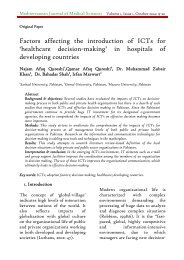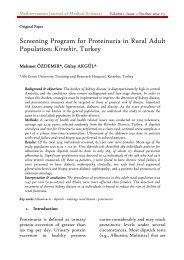Issues and Prospects of e-health in Pakistan
Background & objectives: In connection with access to information in developing countries, information flows through existing networks of communication is a main theme in the current IS literature . Methods:Information-intensive infrastructure is a requirement for information dissemination due to the shortage of network infrastructure in the majority of developing states. It is verified by many researchers that information managing technologies with their main purpose of ‘handling information’ have the advantage to enhance already existing technologies by making better information-communication a priori to new ICT innovations .Presently health information system infrastructure is deficient in resources to meet the demands and needs of increasing population in developing countries. Health care systems of developing countries have major barriers like poverty and lack of technological sophistication. Results:The basic difficulties or barriers in using information technologies include poor or inadequate infrastructure, insufficient access to the hardware and inadequate or poor resources allocation. By eliminating these barriers population health status can be improved in developing countries. Interpretation & conclusion: This study aims to determine the main issues and prospects for ehealth in the current situation of developing countries like Pakistan and the way forward for policy makers to manage all issues in future for more effective and rational decision-making in healthcare organizations. Key words: e-health; challenges; prospects; developing countries; Pakistan
Background & objectives: In connection with access to information in developing countries,
information flows through existing networks of communication is a main theme in the current
IS literature .
Methods:Information-intensive infrastructure is a requirement for information dissemination
due to the shortage of network infrastructure in the majority of developing states. It is
verified by many researchers that information managing technologies with their main purpose
of ‘handling information’ have the advantage to enhance already existing technologies by
making better information-communication a priori to new ICT innovations .Presently health
information system infrastructure is deficient in resources to meet the demands and needs of
increasing population in developing countries. Health care systems of developing countries
have major barriers like poverty and lack of technological sophistication.
Results:The basic difficulties or barriers in using information technologies include poor or
inadequate infrastructure, insufficient access to the hardware and inadequate or poor
resources allocation. By eliminating these barriers population health status can be improved in
developing countries.
Interpretation & conclusion: This study aims to determine the main issues and prospects for ehealth
in the current situation of developing countries like Pakistan and the way forward for
policy makers to manage all issues in future for more effective and rational decision-making
in healthcare organizations.
Key words: e-health; challenges; prospects; developing countries; Pakistan
Create successful ePaper yourself
Turn your PDF publications into a flip-book with our unique Google optimized e-Paper software.
Mediterranean Journal <strong>of</strong> Medical Sciences V1, I1 October 2014: 31-52 42<br />
EHR as the longitud<strong>in</strong>al cradle-tograve<br />
records readily accessible<br />
<strong>and</strong> available over the Internet.<br />
These records will be l<strong>in</strong>ked to<br />
cl<strong>in</strong>ical protocols <strong>and</strong> guidel<strong>in</strong>es to<br />
drive the delivery <strong>of</strong> <strong>health</strong>care to<br />
the <strong>in</strong>dividual. The presence <strong>of</strong><br />
these records over the Internet<br />
facilitates record shar<strong>in</strong>g between<br />
physicians. However, patients<br />
usually feel that they are los<strong>in</strong>g<br />
control <strong>of</strong> their data hence<br />
resist<strong>in</strong>g e-<strong>health</strong>care adoption.<br />
3.2 <strong>Prospects</strong> <strong>of</strong> e-Health <strong>in</strong><br />
<strong>Pakistan</strong><br />
The <strong>health</strong>care facilities <strong>in</strong><br />
<strong>Pakistan</strong> has got better <strong>and</strong><br />
<strong>in</strong>creased <strong>in</strong> figure each year but<br />
this <strong>in</strong>crease is not proportionate<br />
to the population growth<br />
.Therefore; the <strong>health</strong>care<br />
facilities are not that enough<br />
which can fulfill the needs <strong>and</strong><br />
necessities <strong>of</strong> a large population.<br />
Persons particularly <strong>in</strong> rural areas<br />
face more difficulties <strong>of</strong> poor<br />
<strong>health</strong> than the people liv<strong>in</strong>g <strong>in</strong><br />
urban areas. Likewise, there has<br />
been a rise <strong>in</strong> expenses on<br />
<strong>health</strong>care plann<strong>in</strong>g <strong>and</strong><br />
implementation but these<br />
expenditures on more <strong>and</strong><br />
exp<strong>and</strong>ed <strong>health</strong>care setups are<br />
not enough for the population<br />
which is grow<strong>in</strong>g faster than the<br />
<strong>in</strong>crease <strong>in</strong> the expenditure<br />
(Saleem, 2009). Moreover, there is<br />
also an <strong>in</strong>crease <strong>in</strong> the number <strong>of</strong><br />
doctors, dentists <strong>and</strong> physicians<br />
every year .The <strong>in</strong>crease <strong>in</strong><br />
doctors <strong>and</strong> dentists number is<br />
more than the population growth<br />
which has decreased the number<br />
<strong>of</strong> patients/people for each doctor<br />
<strong>and</strong> dentist for treatment.<br />
In the present times <strong>of</strong><br />
management, a practical <strong>and</strong><br />
structured <strong>in</strong>formation system is<br />
more or less a need <strong>and</strong> ma<strong>in</strong><br />
concern <strong>of</strong> many organizations<br />
especially the <strong>health</strong>care<br />
<strong>in</strong>stitutions. In <strong>Pakistan</strong>, the old<br />
techniques <strong>and</strong> methods for data<br />
collection <strong>and</strong> analysis must be<br />
changed if the <strong>in</strong>formation <strong>in</strong><br />
<strong>health</strong>care sector is to be used<br />
correctly for more effective<br />
<strong>health</strong>care-related activities <strong>and</strong><br />
decisions. The M<strong>in</strong>istry <strong>of</strong><br />
Health, Government <strong>of</strong> <strong>Pakistan</strong>,<br />
<strong>in</strong> alliance with the prov<strong>in</strong>cial<br />
<strong>health</strong> departments <strong>and</strong><br />
<strong>in</strong>ternational agencies developed a<br />
National HMIS dur<strong>in</strong>g 1990-93<br />
(Ali & Horikoshi, 2002). The<br />
facility based HMIS is one <strong>of</strong> the<br />
most <strong>in</strong>fluential tool for the<br />
plann<strong>in</strong>g <strong>and</strong> management <strong>of</strong><br />
<strong>health</strong>care services. In view <strong>of</strong> the<br />
exist<strong>in</strong>g huge <strong>health</strong><br />
<strong>in</strong>frastructure, stretched all over<br />
the country <strong>in</strong> terms <strong>of</strong> <strong>health</strong><br />
facilities, services, staff, drugs <strong>and</strong><br />
supplies etc. there has been a<br />
requirement to start a wellorganized<br />
<strong>in</strong>formation system<br />
respond<strong>in</strong>g to the <strong>in</strong>formation<br />
needs <strong>of</strong> various decision mak<strong>in</strong>g<br />
©2014 Mediterranean Center <strong>of</strong> Medical Sciences








